An Unmarked Holocaust Mass Murder Site in Riga, the Latvian Capital
INTERVIEW WITH RIGA HISTORIAN MEYER MELLER (MELERS)
by Aleksandrs Feigmanis
The great Russian author Lev Tolstoy wrote in his story “From the Notebook of Prince D. Nekhlyudov. Luzern.”
“Seventh July 1857 in Luzern in front of the Schweizerhof Hotel, where most rich people would stay the itinerant beggar-singer sings songs for half an hour and plays his guitar. About a hundred people heard him. Three times the singer asked the crowd to give him some moneys or food. Nobody gave him anything and many laughed at him.” […] This is the event which the historian of our times should write about with fiery irascible letters. This event is much more important and serious and has much more sense than the facts written in newspapers and history books. […] This is not a fact for the history of human acts, but for the history of progress and civilization.”
◊
What is the history of the site? To find out I interviewed Mr. Meyer Meller (in Latvian: Melers), survivor and veteran researcher at the museum called “Jews in Latvia” and author of the book Sites of Memory: Jewish Communities of Latvia Annihilated in the Holocaust” (Shamir: Riga 2010, in Russian).
Here are excerpts from what Mr. Meller told me during our interview:
“For the first time I encountered information about Dreilini Forest during the well-known Aktion of “Dunamuende” ― the action of killing of German and Austrian Jews at the end of March and beginning of April 1942. In the KGB documents from the investigations it was discovered that killings of Austrian Jews and German Jews took place in Bikernieki Forest and in Dreilini Forest.
“Then I looked into maps in current phone books and there this memorial place is mentioned. I went to the chief city architect of Riga Mr. Asaris and he gave me documents about this memorial. In Soviet times, at the start of the 1950s a fence was erected around the grave and a wooden plank was put on a metallic tube with an inscription. With time the wooden plank was taken down and a heap of dust was scattered over the spot. The authorities became interested in this fact and wrote to the Riga committee of the party asking for action to improve the situation.
“An additional investigation showed that German and Austrian Jews were brought to the Dreilini Forest to be killed. In 1943-1944 the mass grave was excavated by a special unit of Jewish and Russian military prisoners.” The corpses were excavated and burned to hide the Nazi crimes. The members of this unit were doomed. Later a Soviet investigation commission found three large mass graves in Dreilini.
“The main killings in Dreilini Forest were carried out at the end of August and start of September 1944 [precisely during the times when the Latvian SS legion “bravely defended” Latvia against the Soviet Army. ―A.F.].
“In July [of 1944] the Soviet army liberated Jelgava from the Nazis. The road to the west was cut, and the question arose for the Nazis, where to evacuate Russian and Belarusian civilians, old men, women and children who were members of partisans’ families that had been deported to Latvia by Latvian police battalions (including the Arajs commando). The Latvian police battalions fought partisans in those countries, including Belovezhskaya Pustcha (a deep forest in White Russia), where they told Soviet partisans that they are Latvian anti-Nazi partisans. Then they gave up Belarusian partisans to the Nazis, and burned villages, but old men, and the women and children were deported to Riga. They were settled in the Riga Ghetto and in the Salaspils concentration camp. The question arose what to do with those people, because the Soviet army was already very close.
“For this reason the Nazis decided to organize a gruesome conveyer. This civilians were put in tracks, two men lowered a man from the track, another one beat him with a wooden plank to drown out the screams, and then these half-dead people were put on fire. The perpetrators were Germans. The victims were old people, women and children. The victims spoke Latvian, Belarusian, Russian, and Ukrainian. The witnesses heard the shouting of victims:
‘Killers!’
‘Dear mother, do not leave me!’
‘Oi, panochek [Mr. in Polish or Byelorussian languages[, do not kill!’
“Those who tried to run away the Nazis caught with the help of specially trained dogs and those people were immediately shot.
“After the war the question arise in the 1980s, why a confusing covering of dust was made on the place of the mass killing. The site was cleaned and a new sign was installed. According to information from the Latvian SSR Ministry of Culture it was written on the sign that over thirteen thousand victims of the Nazis lay buried at the site. The monument with this inscription was included in the list of monuments under protection of the Latvian SSR.
“We know that mostly German Jews were killed in Dreilini, but some Latvian Jews from the Riga Ghetto and from Kaiserwald were killed there too. Over the last thirteen years, the Latvian Jewish Community started to put in order dozens of Holocaust killing sites all over Latvia. However, it was my view that because not only Latvian Jews and not only Jews were killed there, but in fact, victims were from different parts of the Soviet Union and from abroad (Lithuania, Germany, Austria and probably some other countries) the monument would best be a joint project of the countries of origin of the victims.
“The idea was as follows. We agreed on one text that would appear in Belorussian, English, German, Latvian, Russian, and Ukrainian. I met with the ambassador of Germany, who agreed to participate. I spoke with representatives at the embassy of Ukraine. He told that in Latvia there are too many sites for Ukrainian victims of the Nazis, and that we should ourselves pay for cleaning up such sites. They told us they were not interested in participating. The ambassador of Ukraine said: “Why are you speaking to me, you should write to the Council of Ministers of Ukraine.” I was confused: Why should I write to the Council of Ministers of Ukraine when a representative of the Ukrainian state, the ambassador himself, is right in front of me. Why is he not interested to write to government bodies? He should do that, not me!
“Later the Latvian society “Memorial” decided to install the monument, but they needed support of related countries and official permission and support from Latvian governmental and municipal institutions.
“The vice-president of the Latvian Jewish community came to the office for the administration of the Latgalian suburb of the Riga municipality, where the Dreilini Forest is located (Latgales priekspilsetas izpilddirekcija). At first they supported the idea of installing a monument I gave the municipality all the documents related to Dreilini Forest. At that time the humble tin sign was desecrated in Dreilini forest. Some antisemite wrote: “Death to the Yids” (“Zdes izdohli zhidi”).It was in the year 2005 or 2006.
“To place a new monument the permission of the Latvian Monuments Commission is necessary. Representatives of the Latgalian suburb’s administration, part of the Riga municipality went to the same Monuments Commission (the chief of the Commission was Sparitis, now president of the Latvian Academy of Science). For unknown reasons, the Commission denied permission for the monument. That was the end of the suburb administration’s efforts to obtain the go-ahead for a monument to be placed on the site of these Nazi mass murders.
“With that the history was finished. Finished with nothing. There were many articles in newspapers (for example: Telegraf, February 4, 2009, page 5), but to this day nothing has been done.”
Finally, I asked Mr. Meller on last question. In his opinion, who should coordinate the work for the construction of a monument?
“My opinion is that the coordination should to be carried out by ‘Austrumu izpilddirekcija’ [administration of the eastern sector] of the Riga municipality, with support from the Latvian Jewish Community and from Germany, Austria, Lithuania, Ukraine, Belarus, Russia, and ,probably, the Czech Republic.”
Clearly, the construction of such a monument might well become a beautiful example of cooperation between different countries of Europe from the Atlantic to the Ural mountains. It would be a common project to commemorate the victims of the Nazis and contribute to a new Europe that would never allow such killings or desecrations to take place in the future.Because to date the story of Dreilini, a mass murder site with no marking, is shameful. To end with the same words of Tolstoy, this truly “is not a fact for the history of human acts, but for the history of progress and civilization.”
Historian Aleksandrs Feigmanis, MA and PhD, is a genealogist and tourist guide at www.balticgen.com. He may be contacted at: aleksgen@balticgen.com.
------------------------------------------------------------------------------------------------------
Images from the March 16th 2013 Annual Glorification of Latvian Waffen SS in Riga
by Monica Lowenberg
Riga, 1943: Latvian soldiers proudly march with a Latvian flag and a Nazi flag. Some of the men were conscripted into the Waffen SS, but a number were volunteers.
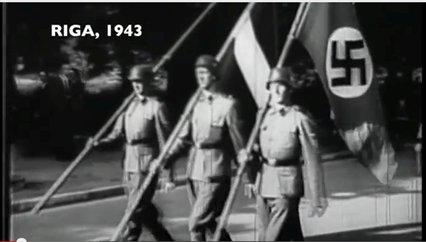
◊
Laying of the wreath to the victims of Nazism by an international delegation of politicians that included: Hon. Tatiana Zhdanoka MEP, Latvia; Hon. Gert Weisskirchen MP (1976-2009), OSCE Commissioner on Antisemitism (2005-2008), Germany; Hon. Nikolais Kabanovs MP, Latvia; Joel Rubinfeld Co-President of the European Jewish Parliament, Brussels, Belgium; Hon. Giulietto Chiesa MEP 2004-2010, Italy; Hon. Marina Solodkina Member of Knesset, Israel 1996-2013 (far left); Hon. Inna Supac MP, Moldova.
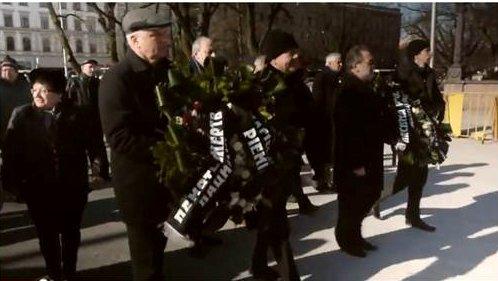
◊
Joseph Koren, chair of Latvia without Nazism, standing next to the wreath to the victims of Nazism at the Monument of Freedom in central Riga, March 16, 2013.

◊
This year the high court demanded that the march must take place and that the mayor of Riga who, in previous years, has always tried to ban the march and allows the wreath to the victims of Nazism be placed at the Monument of Freedom, apologize for all the years he had tried to ban the march. Nils Ušakovs , Riga’s (ethnic Russian) mayor, has always insisted: “It is a bit difficult to claim to be a hero if you were fighting for the Nazis.”
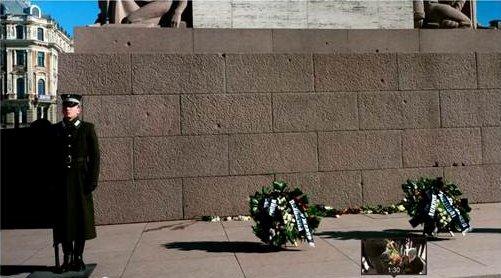
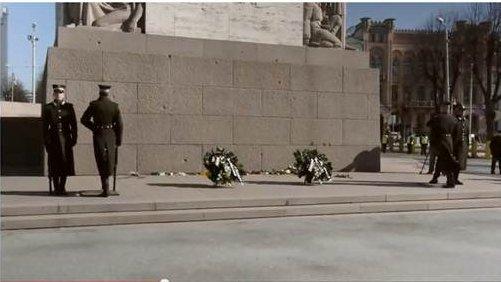
◊
Hon. Gert Weisskirchen MP (1976-2009), OSCE Commissioner on Antisemitism (2005-2008), Germany looking on at the Monument of Freedom.


◊
The anti-Fascists protested by putting up photographs of the atrocities that the Nazis, with the help of Latvians, had committed already in 1941. In 1943 these Latvians later and willingly joined the Latvian Legion, 15th and 19th detachments of the Waffen SS.

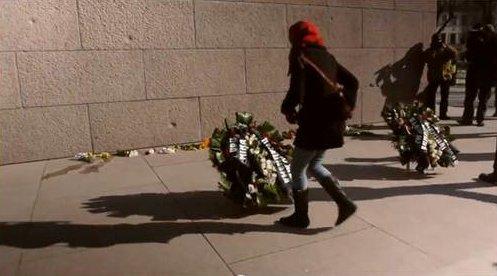
◊
As in previous years, young Latvians arrived at the Monument of Freedom and desecrated the wreaths to the victims of Nazism.
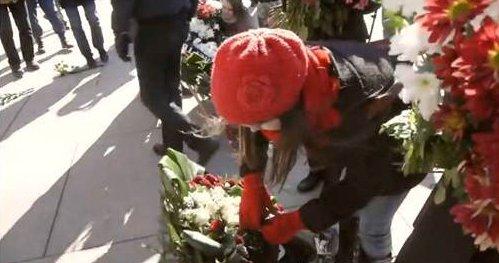
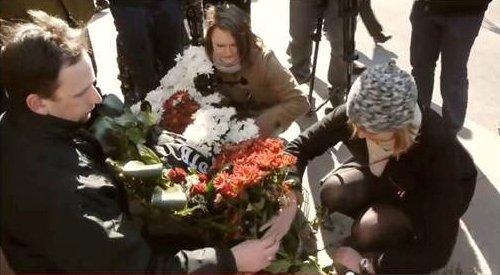

◊
Latvian Nationalists believe that the Latvians were victims of two occupational powers the Nazis and Communists and victims of two genocides. The first point is correct , the second is not.
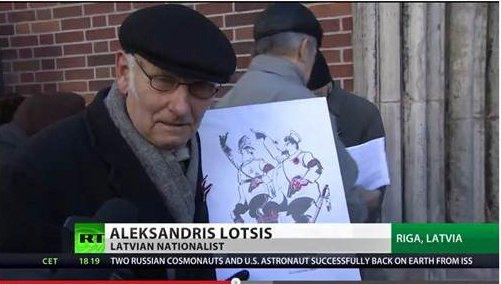
◊
The march begins and hundreds of young Latvian men and women between the ages of 18-25 arrive at the scene. Some 70% of the attendees are young people.

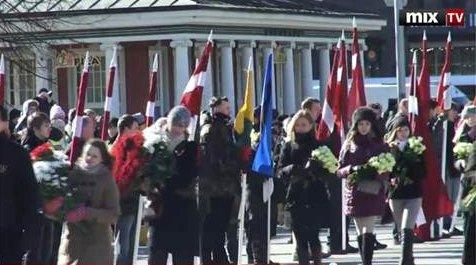
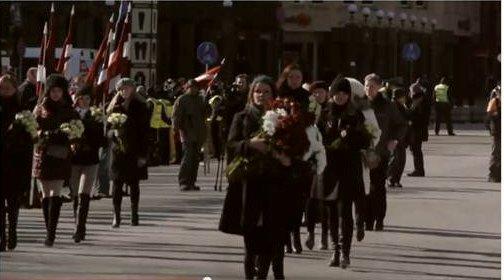
◊
A photograph of one of the most decorated Latvian Waffen-SS officers, Roberts Ancāns, is placed at the base of the Freedom Monument.
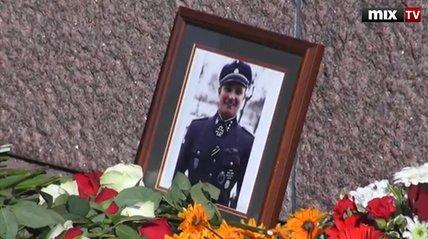

◊
Children as young as three attended the march.
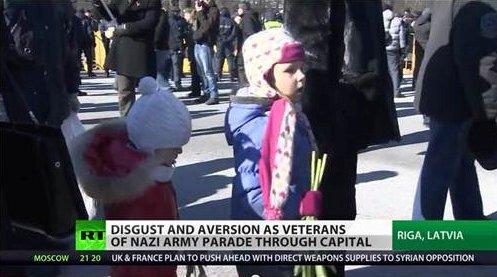
◊
Riot police cordoned the path to the Monument of Freedom.
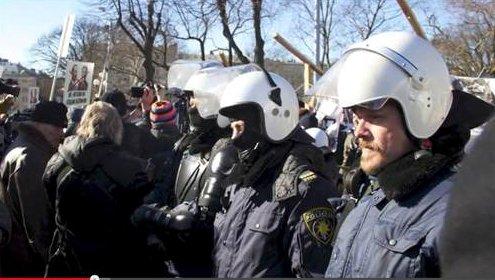
◊
Hundreds commemorated the Waffen SS divisions in Latvia to the outrage of anti-fascists.

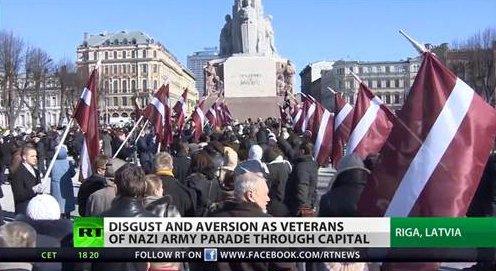
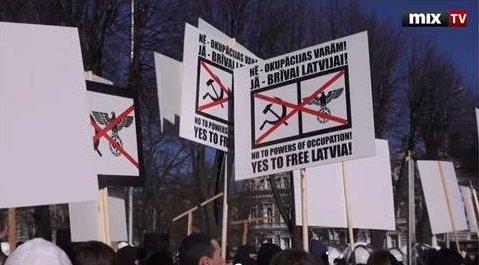
◊
Latvian nationalists sang romantic songs of mythical heroes and days gone by whilst former Latvian Waffen SS veterans arrived dressed in uniforms.
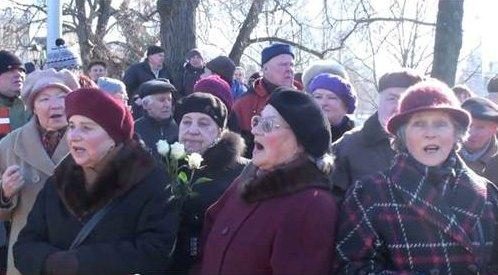

◊
Raivis Dzintars, pictured right, is co-chair of the Latvian far right party which entered the ruling coalition in 2011. Dzintars is a member of the National Association “All For Latvia!”- “For Fatherland and Freedom/LNNK” and amongst his various parliamentary duties he is, disturbingly, since November 2011, chairman of the civic education subcommittee of the Education, Culture and Science Committee.
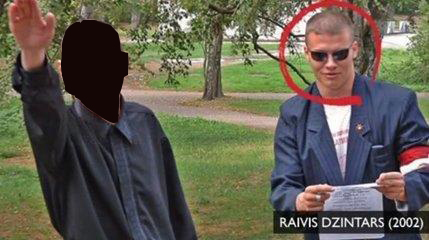
◊
This year Raivis Dzintars and Janis Dombrava of National Association “All For Latvia!”— “For Fatherland and Freedom/LNNK”, aggressively approached protesters and tried to tear down photographs of atrocities committed by Latvian collaborators in 1941, men who later joined the Latvian Legion in 1943.
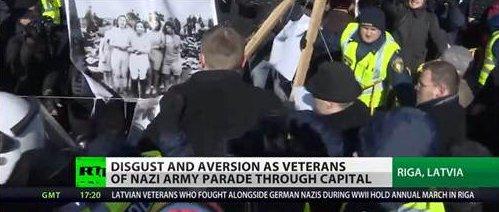
◊
Journalist Egle Samoskaite on Delfi.lt, writing for her readers from a Lithuanian perspective, saw in Riga both Cekutis and Panka. In other words, at least TWO masterminds (Panka and Cekutis) of the fascist marches in Lithuania (with swastikas, White Power signs, Sieg Heils etc), were in RIGA to pay their homage to the Waffen SS.
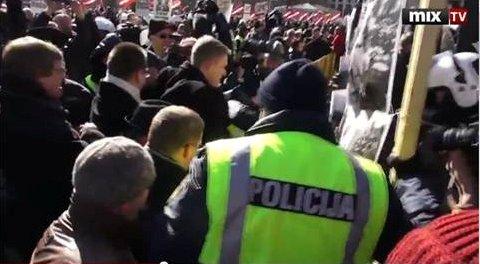
◊
Protester Joel Rubinfeld, co-president of the European Jewish Parliament in Brussels, was dragged away by armed police when he requested that the wreath to the victims of Nazism be restored.
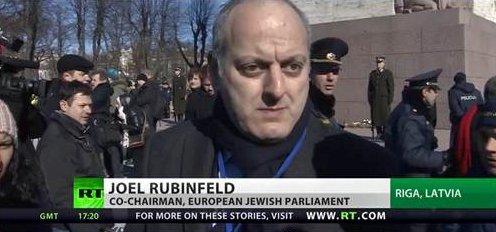
◊
Four people were detained by police and after giving an interview with a TV station, Yaniz Kuzins, chairman of Latvian Alliance against Nazism and Riga City Council member, was physically assaulted by a neo-Nazi whilst nationalists presented protesters with photographs of the Latvian Waffen SS in their Nazi uniforms.
Ambassador Stiprais,Latvian ambassador to UK, has brazenly defended the march for the second year running and stated to concerned Conservative MP David Amess, “No Nazi uniforms, symbols or slogans appear on 16th March.”
◊
Hon. Gert Weisskirchen MP (1976-2009), OSCE Commissioner on Antisemitism (2005-2008), Germany speaking at the anti-fascist conference after the march, a conference Nationalists tried to discredit by claiming to the Latvian press that all the attendees were KGB agents.

◊
Journalist Richard Brodsky and a member of the New York State Assembly explained why we should be vigilant in the face of events such as the 16th March and showed a pack of playing cards glorifying Waffen SS soldiers, a pack he picked up only that day in a shop in Riga.
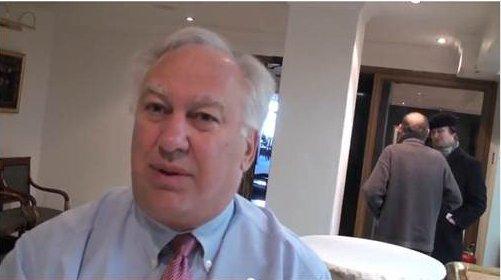
◊
No glorification of Waffen SS, Ambassador Stiprais?

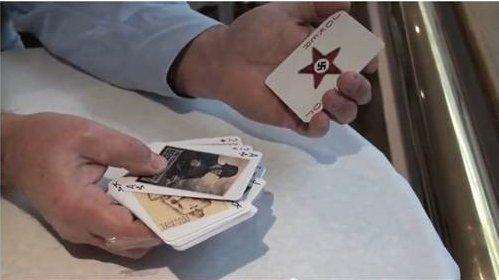
Latvian Ambassador to the UK Comments on March 16th Waffen SS March in Riga
LONDON—Latvia’s ambassador to the UK has responded to a UK Conservative Party MP’s question about the Waffen SS events held in the center of Latvia’s capital, Riga, on March 16th each year. The office of UK Parliament MP David Amess, who represents Southend West, released the response dated 1 March 2013, which he received from the Latvian ambassador to the UK, HE Eduards Stiprais. It is reproduced in full below (as PDF here), courtesy of the office of Monica Lowenberg in London, whose petition and media guide have brought the Latvian SS marches to increased international scrutiny.
MONICA LOWENBERG’S REPLY TO THE LATVIAN AMBASSADOR IN 2012
See also Monica Lowenberg’s 2012 exchange of ideas with the Latvian ambassador to the UK. More in Defending History’s Latvia section.
http://defendinghistory.com/
The laying of the wreath for the victims of Nazism by:
- Efraim Zuroff, Director of the Simon Wiesenthal Center (Israel),
- Hermann Dvorzak, leader of the European Social Forum (Austria),
- Monica Lowenberg , British academic and initiator of the petition 'Stop the 16 March
- marches and Latvians revising history' (UK),
- Dovid Katz, ex-professor of the Vilnius University, owner of DefendingHistory.com (USA/Lithuania),
- Joel Rubinfeld, president of the European Jewish Parliament (Belgium),
- Joseph Koren, president of the association "Latvia without Nazism" (Latvia)
- Helmut Scholz, EP deputy (Germany),
- Tatjana Ždanoka (Tatyana Zhdanok), EP deputy (Latvia)
One of the
powerful voices in the small counter-demonstration at last year's Waffen SS
celebration in central Riga was Joel Rubinfeld, co-president of the European
Jewish Parliament (Brussels). 'You are here to enforce the law!' Joel Rubinfeld
tells a Latvian policeman.
Glyn Ford, UK Labour Party, Brussels states, 'Any government that endorses this
kind of action is cause for concern'.
http://defendinghistory.com/
OPEN LETTER TO THE PRESIDENT OF THE EUROPEAN COMMISSION BY ROLAND BINET
Mr JOSÉ MANUEL BARROSO, RELATED TO THE “OCCUPATION MUSEUM” OF RIGA IN LATVIA
Mr President,
Dear Mr Barroso,
I recently visited the “Occupation Museum
That museum prides itself on having thus welcomed a number of well-known symbolic personalities. Your persona grata is all the more important now that the EU has become an unavoidable partner in the world and, furthermore, now that Latvia
This small museum is indeed remarkable. It depicts and illustrates, sometimes in a most harrowing manner, what the Soviet terror must have been like for the inhabitants of that country invaded by the USSR in June 1940, then, reinvaded by the “liberating forces” of the Red Army after the defeat of the Germans. Without any shadow of a doubt, hundreds of thousands of Latvian patriots have known the anguish of repressive methods, slavery of the mind, deportation to the Gulag, forced exile in Siberia or other inhospitable places, or even death.
An extremely reduced part of the permanent exhibition allows us to have a very vague representation of the Holocaust in Latvia Liepāja Latvia
I can understand that the part devoted to the Holocaust might be restricted compared to the decades of horror sustained by the Latvian people under Stalin, then Brezhnev, the NKVD, then the KGB. After all, the murder of the Jews of Latvia
Except that in Latvia Western Europe .
And, a bit naively, I ask myself the following question: would there be another underlying reason in what I consider – in proportion – such a modesty of display regarding the pain, losses and deaths that the Latvian Jews had to undergo during WWII? This renowned museum conceived for a broad public of visitors largely ignorant of the bare facts related to the war is a showcase of the two “occupations” in fact. But does it represent the reality in the matter of one of the most monstrous genocides ever committed? And I am speaking here of the extermination of the Jews in a global Nazi undertaking of murdering whole segments of populations, of a magnitude and purpose extremely abyssal. And another question: if the Occupation Museum in Riga were really a showcase aiming at giving an honest representation - to foreign visitors not really cognisant of the terror experienced by the Latvian people as a whole during the Soviet and Nazi years of occupation -, does it fulfil its purpose ?
In order to judge in an impartial manner, one has to go back to different sources, be they testimonial, historical or governmental, in order to understand fully what really happened to the Jews in Latvia
The Latvijas Institūts of the Occupation Museum Warsaw
The Ministry of Foreign Affairs of the Republic of Latvia points out in a text available on its website, written by I. Feldmanis and K. Kangeris that: “No community can be judged on the basis of what individuals have done ». Furthermore, one can read the following assertion: “The last document, the 10th, is one, which is most familiar to historians. It has to do with the 1943 events in Warsaw
Raul Hilberg has this to say about the possible involvement of Latvians at the time of the first massive round-ups of Jews in the Warsaw Riga for the big round-up in the Warsaw
(Sir) Martin Gilbert: “That same day, July 22, the ghetto walls were surrounded by Ukrainian and Latvian guards, in SS uniforms, armed, and at twenty-yard intervals. The round-up and deportation of Jews from Warsaw
Emmanuel Ringelblum: “Why could 50 SS (according to others even less) helped by some 200 Ukrainians and an even number of Latvians guards, proceed in such an easy way during that operation?”[v]
Hillel Seidman: “Thursday 23 July – Panic in the ghetto. Everyone is suffering from despair. The militia made up of Ukrainians, Latvians and Lithuanians encircle the housing blocks of the ghetto. One of the militiamen goes inside the courtyard and orders that all inhabitants come down. Then, the Jews are placed by groups and they are led to the goods’ loading and unloading station, the Umschlagplatz.”[vi]
Even more astonishing a website source entitled “Latvian Battalion in Poland and White Russia ”, a site that glorifies the action of these Latvian battalions during WWII, states the following: “272. Daugavgrivas Battalion started to be formed by Pltn. K. Mangulis 1st July 1942 in Bolderaja (…) 25th of July, the battalion armed with Russian and Canadian guns, together with the 22nd Daugavas Battalion left for Warsaw where they arrived 31st of July. In Warsaw the battalion was to fulfill guard duty and during free time finish training (…) 26th of July 1942 at Warsaw arrived the 22nd Daugavas Battalion (…) In Warsaw 1942.” [vii]
As one can immediately ascertain by beginning with a few selected sources, there is an acute controversy in reference to the exact role that other armed Latvians than those belonging to the Viktors Arājs Commando may have played in the Nazi undertaking of liquidating Jews, in Latvia as well as in other foreign countries . One can also note that official sources tend to “downplay” possible involvement. “Guard duties” when one is referring to innocent Jewish victims being driven by force to an “Umschlagplatz”, sometimes shot on the spot when refusing or unable to move, and then forcibly put into death trains to Treblinka, are these in fact mere guard duties?
In order to ascertain and understand the possible participation of Latvians in the murder of the Jews, one should, first and foremost, hark back to the past of Latvia USSR in 1940 in accordance to the secret clauses of the Non-Aggression Pact signed between (Nazi) Germany and the USSR Russia Moscow Latvia
When the Germans invaded Latvia Occupation Museum
Another source of discontent toward the Jews is that that oppressed minority welcomed the arrival of the Red Army. There had always been a kind of sympathy or leniency in relation to
When the Nazis attacked the Soviet Union on June 22, 1941, they rapidly progressed within the Baltic States . Hundreds of thousands of Jews fled their homes and took after the retreating Soviet soldiers. They were lucky because immediately after the occupation of the main towns and cities of Latvia, and in particular in Riga, the Germans appear to have given a carte blanche to the local population so that they might take revenge on the Jews who – for some gullible persons – were held responsible for collaboration with the Soviets and for the enforced deportation of thousands of innocent Latvians.
The Ministry of Foreign Affairs of the Republic of Latvia claims that Soviet sources and present Russian authorities are responsible for having stated that Latvian SS units or other organisations were guilty of participating in the mass massacre of the Jews, in a text available on its website, written by I. Feldmanis and K. Kangeris: “The ministry's memorandum (i.e. the Russian Foreign Ministry's Department of Information and Press Relations) is yet another attempt to describe the history of Latvia, and particularly of the Latvian Legion, as an issue of "national chauvinism" and "collaborationism". The document speaks to the emergence of pro-Fascist organisations, which supposedly emerged after World War I. It says that the "Aizsargi" (Home Guard) organisation appeared and helped the leader of the Latvian Farmers Union , Kārlis Ulmanis, to stage his coup on May 15, 1934. In the late 1930s, according to the authors of this document, the Home Guard, members of the Pērkoņkrusts (Cross of Thunder) organisation and other nationalists began to collaborate with Germany
These are claims that were made in the 1960s by Soviet propagandists, and today the Department of Information and Press Relations of the Russian Federation
Yet, numerous other sources contradict that official Latvian point of view.
Yet, there are pictures showing us that as soon as July 2, 1941, self-proclaimed self-defence bands (pašaizsardzības spēki) or mere groups of civilians arrested and escorted Jews.[x]
What do others have to say on that subject?
Elmar Rivosh: “Latvian volunteers materialized from somewhere, wearing armbands with the national colours. In groups of several men, sometimes accompanied by a German, they began to make rounds of people’s houses. The caretakers had to point out the Jewish homes. They came in, searched, beat the inhabitants, confiscated valuables, and took away most of the men.”[xi]
Bernhard Press: “Lithuanian Jews who had fled the Germans to Riga from Kaunas , Siauliai Gogol Street
Ella Medalye (one of the few survivors from the Rumbula Forest massacres): “On the first day of the occupation (i.e. July 1, 1941, in Riga Riga 13 Tomson Street
Iossif Rotchko about the murder of the Jews in the chapter “The Holocaust in Latgale: in Līvāni, Preiļi, Kārsava, Višķi, Dagda:
Pages 257/258: « On July 28, 1941 the first act of the tragedy befalling the Jews of Preiļi was initiated. During the morning, members from the self-defence militia gathered on the market place. They were given weapons to proceed with the execution of the Jews. The other armed policemen were in position to avoid that troubles might happen in the town, because all inhabitants were not in favour of that execution...”
Page 258: “The unfortunate (i.e. the Jews) were ordered to stop at a stone quarry. They were ordered to take off their clothes and remain in under-clothes, then they were led to the edge of the pit by groups of 8/10 persons. The executioners killed them by firing at their backs, as if they were afraid to look in their eyes a final time. After all, they were neighbours. The killers were conducted to the killing ground by carts driven by the farmers I.
Why was it possible that there were spontaneous or induced pogroms committed by Latvian civilians, policemen or self-proclaimed militiamen at the very beginning of the occupation of Latvia
The « Latvijas Institūts » of the Occupation Museum
What have other voices to say on that matter? Was there anti-Semitism in Latvia
Bernhard Press: “In 1933, Hitler came to power. In Latvia Buffalo textile factory in Riga
Boris Volkovitch in the part entitled “Anti-Semitism and the discrimination against the Jews” in the chapter entitled “The Jews of Latvia
Page 20: “The Latvian government was never able to restrain the anti-Semitic manifestations. The anti-Semitic propaganda was spread by means of xenophobe press articles and the publication of anti-Jewish books and pamphlets. Rightist news papers as for example Tautas Balss (the People’s Voice), Latvijas Sargs (the Latvian Sentry), Latvis (the Latvian), Zemgalietis (Zemgalian), Pērkoņkrusts (Cross of Thunder), Zilais Erglis (the Blue Eagle), Tautas Vairogs (the People’s Shield) as well as others led a war of ideological terror against the Jews, generally, and most particularly against the Latvian Jews.
Page 33 (of the part entitled “Some conclusions” of the same chapter): “The policy of discrimination practised by the government with regard to the minorities (and more particularly against the Jews) had negative consequences in numerous fields. The discontent increased, among the younger generations chiefly (because of employment, career opportunities, the quotas in the higher educational establishments, etc.). The minorities retired more and more within themselves. As regards the Jews, some went back to their roots and prepared themselves to leave Latvia for other countries (including Palestine Germany
(Sir) Martin Gilbert: “In the former Latvian city of Dvinsk (i.e. Daugavpils
The “Shoah Resource Center” of Yad Vashem, (in a Reich Secret Document relating to the Einsatzgruppe A): « Even in Riga it proved possible by means of appropriate suggestions to the Latvian auxiliary police to get an anti-Jewish pogrom going, in the course of which all the synagogues were destroyed and about 400 Jews killed. As the population on the whole quietened down very quickly in Riga Latvia
Leni Yahil: “In the Baltic states the SS availed themselves, intensively and entirely in a conscious way, of the heavy anti-Semitism which could be found in large strata of the population.”[xxi]
This view seems to be echoed in a passage taken from the “Anti-Semitism” chapter of Andrew Ezergailis’s monumental work on the annihilation of the Jews of Latvia: “One goal of the propaganda was to create a desire for revenge. A special effort was made by Stahlecker’s men to enlist relatives of victims of communism in the killing teams. For this purpose the propaganda apparatus was mobilized and agents were sent out to the countryside to find the kinsmen of the communist victims and cajole them into killing actions (…) the Einsatzgruppen leaders sought out the gravesites of victims of the communists as soon as they arrived in a locale; then they had the dead dug up and displayed the rotting corpses to the public. Digging up graves was the major news at the beginning of the occupation. An especially gruesome tale of an exhumation comes from Rēzekne. A week after the German arrival, the SD men assembled all Latvian local police guards at the edge of a gravesite, and local Jews were made to dig up the pit. They uncovered about thirty half-rotted corpses.”[xxii]
In an article published by the German weekly “Der Spiegel”, the author lets Margers Vestermanis - then aged 80 years old, one of the 30 survivors born in Latvia still living in that country –, the founder of the Museum of the Jews of Latvia – express himself about these times: “Who committed all these murders during the first two months at the time when the German police force was not yet organised? “ He adds: “35,000 Jews have been liquidated exclusively during the first 100 days after the German invasion, of these 30,000 are to be held to account of the Latvian murderers.” [xxiii]
Guido Knopp – a well-known German historian and author of historical documentaries on WWII – quotes what the Führer of the Polizei and Ordnungspolizei for Latvia had to say about the situation in that country, on December 23, 1941: “In Riga Riga
There is also an astonishing document dated December 11, 1941, quoted by Christopher R. Browning and that one can find in a facsimile version on Internet. It refers to the written report that the German lieutenant Paul Salitter, a captain of the Schutzpolizei submitted to his hierarchy after having accompanied a train of Jewish deportees to Riga Riga Dvina ) and the place was secured by means of barbed wire. At this time, only 2,500 male Jews employed at different labour tasks are supposed to be in the ghetto. The other Jews have either been sent elsewhere to accomplish similar tasks, or have been shot by the Latvians. The Latvians hate the Jews, particularly. Since the liberation and until now, they participated massively in the extermination of these parasites. Yet, they have trouble understanding – as I had the opportunity to ascertain with the Latvian personnel of the railways – why the Germans bring their Jews in Latvia
With regard to the tragic history of the annihilation of the Jews of Latvia, Andrew Ezergailis mentions – in the chapter entitled “Conclusions” - these two main points, among others: “The history of the Holocaust in Latvia Riga
As one can ascertain when reading the different accounts from survivors from the Holocaust and historical works, not only did the Commando Viktors Arājs participate in the murder of the Latvian Jews and the Jews deported in Latvia from countries of Western Europe . There were thus pogroms, individual or mass killings, perpetrated by groups of civilians or by self-defence militiamen, by members of paramilitary organisations or movements close to the ideology of Fascism such as the Aizsargi (“defenders”, a nationalist-populist militia founded in 1919, numbering 68,000 members from all strata of society, the principal source of collaborators for the Nazis); there was also the Pērkoņkrusts organisation (strangely enough, a Fascist organization forbidden by the Germans in August 1941 and whose members merged with the Nazis).[xxvii] There were further the Latvian men belonging to the Schutzmannschaften[xxviii] and, finally the “Hiwis” (also called “Askaris”), these last being Soviet soldiers prisoners of war recruited by the Nazis in camps - among whom were Latvians POW’s - whose later military training took place in Trawniki in Poland (also a “KZ”, by the way), and whose reputation for cruelty and savagery is quoted by all historians or witnesses who ever had to deal with these “collaborators” bearing German uniforms.
This is what some historians stated about the “Trawnikis” (another appellation for these “volunteer” troops): “Following the Nazi invasion of the Soviet Union in June 1941, the Nazis encouraged Ukrainians, who were former soldiers of the Red Army and who had been captured, to join their cause. Tens of thousands of Ukrainians volunteered for service in the German security services, as well as Lithuanians, Latvians, Estonians and others (…) The volunteer units were called "Trawnikis" or "Askaris" by the local population. The Germans called them Hilfswillige or Hiwis for short, and the volunteers themselves Wachtmänner. In Trawniki the Wachtmänner received abbreviated military training and exercises, including training for the deportation of the Jews. Approximately 2,000-3,000 guardsmen passed through the training camp during the two and a half years of its activity. Some of them were organised into two battalions with four companies each, about 1,000 men altogether. The size of a company was 100-200 men.”[xxix]
As one can ascertain, the role of the Latvian collaborators in the undertaking of extermination of the Latvian Jews is at least controversial; a number of sources mention an active participation, others - Latvian essentially - deny it completely.
What has a well-known Nazi-hunter to say about the matter of collaboration? “The Germans would never have killed 6 million Jews without the help of hundreds of thousands of collaborators. The Holocaust cannot be summarised by the anti-Semitic madness of the sole Germans and Austrians. The whole continental Europe was associated in the process. In all the countries that they invaded, the Nazis found cruel and zealous volunteers. (…) An important part of the murdered Jews in the three Baltic states were killed by Balts, not by Germans or Austrians. Baltic citizens were by the way sent to foreign countries to take part in the genocide. Lithuanians, Latvians and Estonians went in particular to Byelorussia Baltic states where they were murdered. These three small countries have thus greatly contributed to the liquidation of the European Jews.[xxx]
On May 19, 2005, a text on the actual situation in Latvia, written byVladimir Simonov, was made available on Internet: “A short excursion in Riga with a good guide will only increase the confusion that a foreign observer might feel seeing the outburst of the Nazi spirit in that Baltic state. Anti-Semitic inscriptions sometimes appear on the monuments of Jewish graveyards. Carpets with swastikas are exhibited in shop windows. One can see passers-by bearing metallic swastikas on the chest. Demonstrating an astonishing historical amnesia, Riga becomes indignant with the alleged genocide committed in Latvia Latvia against other citizens of Latvia
What does the same Efraim Zuroff write regarding “the Nazi spirit” symbolised by the annual march held each year on March 16, near the Statue of Liberty in Riga, a march that honours the SS from the Latvian Legion, Latvian SS soldiers of whom some pictures are exhibited at the Occupation Museum (one can also buy a book on the Latvian Legion at the reception desk in the entrance hall). A sight which, to foreign visitors from Western-Europe who grew up with an ingrained hatred of the Wehrmacht and the SS, is and remains utterly shocking: “In reality, Tuesday’s ceremony was in certain respect only the tip of a very dangerous iceberg that is attempting to rewrite the history books and create a false symmetry or equalisation of Communist and Nazi crimes. And while the march was not organised by the government, it is obvious that there is strong support for its message among Latvian leaders. Thus, for example, yesterday Latvia
As for the Latvian SS Legion and the annual march on March 16 in their honour, the present Latvian authorities support the view that these SS units had nothing whatever to do with the extermination of the Latvian Jews, because in fact when these SS units were formed or conscribed according to the Latvian sources, most of the killings of Jews in Latvia had been done.[xxxiii] Yes, but one may perhaps take the opposite view. The Waffen SS units were elite troops that nearly always fought in a harsh and organised manner and succeeded, very often, in containing the advance of the Soviet Army. Might one, therefore, not come to the conclusion that SS combat troops – among which figures the Latvian SS Legion -, that did not kill any Jews directly, delayed the defeat of Nazi Germany. And, inevitably, allowed thus that more Jews in ghettoes, small communities, death camps, in far-away countries (Greece , Italy USSR
It seems to me, thus, that after the fall of the Iron Curtain associated with the fall of Communism we are now witnessing another Iron Curtain being erected with the purpose of giving a minimalist representation of the horrors suffered by the 70,000 Jews of Latvia victims of the murders committed under the Nazi regime; a Manichean vision that forgets to refer to the possible social and political underlying context leading to the war, a silencing process that seems to attribute the major part of that unprecedented catastrophe which happened in Latvia between 1941 and 1945 only to the Viktors Arājs Commando or other militias, a terribly withering process which I think, within limits, smacks of history-rewriting as Efraim Zuroff stated, or, worse, revisionism. And, unfortunately, the Occupation Museum in Riga is part of the alleviating process as far as the exhibits it displays in its permanent exhibition are concerned.
May I therefore ask you to distance yourself from that kind of moral support? It concerns first and foremost, I think, our dignity as citizens of the European Union and our firm and enduring belief in humanistic values that cannot in whatever manner be muted as far as the crimes committed against humanity are concerned.
I thank you beforehand for your attention and kindness.
© Roland Binet – Belgium
25/10/2010
P.S.:
As some of the witnesses’ accounts originate from authors who might be less known to readers experienced in matters relating to WWII, here are some clarifying biographical information about them:
« И ТЫ ЭТО ВИДЕЛ » (i ty eto videl/And You Saw It) by David Silberman, published by BOTA/Riga, ISBN 9984-19-970-3, can be bought at the Museum of the Jews of Latvia/Riga. David Silberman was born in Preiļi in Latvia Israel , David Silberman was one of the leading persons to organise a hunger-strike in Moscow Israel
« THE MURDER OF THE JEWS IN LATVIA Latvia Florence because of covert anti-Semitism in Latvia
« MEMOIRS » by Elmar Rivosh, ISBN 978-9984-39-515-9; this book can be bought at the Museum of the Jews of Latvia in Riga Riga , later Paris Riga USSR
« L’EXTERMINATION DES JUIFS EN LETTONIE 1941-1945 » (The Extermination of the Jews in Latvia 1941-1945), a conferences’ cycle, director of publication Rabbin Ménachem Barkahan, ISBN 978-9984-9835-8-5, published by the « Shamir Association », Riga/Latvia; translated from the original Russian but available in French at the Museum of the Jews of Latvia; this book received the support of the “Agence Exécutive” (Éducation, audiovisuel et culture – EACEA) from the EU. This remarkable book describes in a very thorough manner the social and political context in Latvia Latvia
[i] Website: Latvijās Institūts of the Occupation Museum
[ii] Website: Ministry of Foreign Affairs of the Republic of Latvia , taken from a document entitled « The volunteer SS Legion in Latvia
[iii] « La Destruction des Juifs d’Europe Tome II », by Raul Hilberg, translated from the French version, page 417. The author refers to G. Tessin’s « Zur Geschichte der Ordnungspolizei », the footnote on page 417 states, too, that after the roundup, the battalions were transferred in October.
[iv] « The Holocaust – The Jewish Tragedy », by Martin Gilbert, page 388; the author founds this assertion on Stanislaw Adler’s « In the Warsaw Ghetto 1940-1943: an Account of a Witness », Jerusalem
[v] « Chronique du ghetto de Varsovie » (Diary from the Warsaw
[vi] « Du fond de l’abîme – Journal du ghetto de Varsovie» (‘from the depth of the chasm – diary from the Warsaw
[vii] Can be consulted on Google under « Latvian Battalion in Poland and White Russia »
[viii] In « The murder of the Jews in Latvia 1941-1945 », Bernhard Press writes the following on page 37: « in mid-June the KGB began a large-scale deportation action (…) 20,000 innocent victims from Latvia (…) were sent to Siberia, including about 5,000 Jews from Latvia
[ix] See footnote 2
[x] Pictures at the Museum of the Latvian Jews in Riga
[xi] « Memoirs » by Elmar Rivosh, Riga 2008, pages 21/22
[xii] Ibid footnote ‘6’ (Bernhard Press), pages 45/46
[xiii] « и ты это видел » (i ty eto videl- And you Saw It), by David Silberman, Bota/Riga, page 38
[xiv] « L’Extermination des Juifs en Lettonie 1941-1945 » (the Extermination of the Jews in Latvia
[xv] Ibid footnote ‘1’
[xvi] Ibid footnote ‘6’ (Bernhard Press), pages 29/30
[xvii] Ibid footnote 11
[xviii] « The Holocaust – The Jewish Tragedy », by Martin Gilbert, pages 157/158
[xix] http://www.yadvashem.org/ , search, (General Report up to October 15, 1941 –II - Cleansing {of Jews} and securing the area of operation.)
[xx] « Das dritte Reich und die Juden » (the Third Reich and the Jews) by Léon Poliakov/Joseph Wulf, page 148
[xxi] « Die Shoah » (the Shoah) by Leni Yahil, pages 792/793
[xxii] « The Holocaust in Latvia » by Andrew Ezergailis, page 104
[xxiii] “Der Spiegel”, 17/2005 dated 25/04/2005, an article by Walter von Mayr.
[xxiv] « Holokaust », by Guido Knopp, page 62
[xxv] Paul Salitter’s report, quoted in page 90 of « Des hommes ordinaires » (“Ordinary Men”) by Christopher R. Browning ; the original facsimile report can be consulted on Internet under the search words « Düsseldorfer Polizeigeschichte – Deportation von jüdischen Menschen” , and under http://www.yadvashem.org/ where under the heading “The International School for Holocaust Studies” there is a subject matter entitled “The Transport” Lesson Plan”, where in the text by clicking on “documents” of the “start by reading the documents”, one can access the English translation of the original German report by Lieutenant Paul Salitter. I made a translation from my French version of that report
[xxvi] See footnote 22, page 376
[xxvii] Cf. Glossary in « L’Extermination des Juifs en Lettonie 1941-1945 », cycle of conferences, publishing director Rabbi Menachem Barkahan, written by Grigory Smirine, Doctor in History
[xxviii] Cf. footnote 1
[xxix] Gutman , Israel Arad
[xxx] « Chasseur de nazis » by Efraim Zuroff with Alexandre Duyck, pages 86/87
[xxxi] Website of ResistanceS/Belgium, can be consulted in French on the website www.resistances.be/ , posted May 19, 2005
[xxxii] Efraim Zuroff’s article in The Guardian » of March 18, 2010, entitled « Dangerous history-rewriting in Latvia
[xxxiii] An extended explanation can be read on the website of the Ministry of Foreign Affairs of the Republic of Latvia
MEDIA
DOCUMENTARY
"After all we survived- The Riga Ghetto." 98 Min. DVD
"After all we survived- The Riga Ghetto." 98 Min. DVD
Director Jürgen Hobrecht
Production Polis Film
All rights reserved Berlin 2013
Details and outtakes
(English version coming soon)
Zwischen November 1941 und Oktober
1942 werden rund 22.000 Juden aus dem Deutschen Reich nach Riga verschleppt.
Unmittelbar vor der Ankunft der deutschen, tschechischen und österreichischen
Juden in Riga werden an nur zwei Tagen 27.000 lettischen Juden und Jüdinnen
ermordet, um Platz für die Neuankömmlinge aus dem Reich zu schaffen. Auch
Tausende Deportierte aus dem Deutschen Reich werden direkt nach der Ankunft
erschossen. Diejenigen, die das Ghetto lebend erreichten, erleiden jahrelange
Qualen.Von 24.605 in den Jahren 1941 bis 1942 nach Riga deportierten Juden aus
dem „Großdeutschen Reich“ überleben nur 1.073.
Zeitzeugen berichten in dem Film von
dem Massaker an den lettischen Juden, dem Leben im Ghetto und dem Überleben mit
dem Trauma.
Interessenten an Filmvorführungen in
Schulen, Gedenkstätten, Museen etc. sind herzlich willkommen. Die DVD
kann für 12,00 + 3,00 Versand bei info@phoenix-medienakademie.com bezogen
werden.
Between
November 1941 and October 1942, 24.606 Jews from the "Deutsche
Reich" (Germany, Austria, and Czechoslovakia) were deported to Riga.
4.500 were shot on arrival. The remaining Jews were sent to
the Reichsjudenghetto and Jungfernhof and forced to live in an
area where about 13,000 people had lived previously. However,
before the "Reichsjuden" had been deported to Riga, to make
room for the new arrivals, some 25,000 Latvian Jews out of 30,000,
who had been placed into the Riga ghetto from August 1941
onwards were, over only two days, shot by the Nazis and willing
Latvian collaborators. The brutal murder of Latvian Jews was one of the
second-worst atrocities in the first stage of the Holocaust and yet,
until now, this terrible chapter has rarely been spoken or written about.
Those who
survived the ghetto suffered for years after. Out of the 24.606
ReichsJuden who were deported to Riga between 1941-1942, only 1,073 survived .
In Hobrecht’s
new film, German and Latvian survivors speak out for the first time
about the massacre against the Latvian Jews, the living conditions in the
ghetto and how they survived the trauma.
Media List for March 16th 2012
and 2013:
Petition:
You can add your voice to this
petition here: http://www.petitions24.com/stop_the_16_march_marches_and_latvians_revising_history
Recent talks
in Riga, Latvia regarding the Latvian SS, the Red Brown Commission
and Prague Declaration
Conference on East
European Holocaust memorials in Riga, 27-28 May 2013
http://defendinghistory.com/wp-content/uploads/2013/05/Riga-Holocaust-conference-27-28-May-2013.pdf
http://defendinghistory.com/wp-content/uploads/2013/05/Riga-Holocaust-conference-27-28-May-2013.pdf
Video of Dovid Katz's recent talk at conference in Riga, Latvia:
http://youandus.theus.org.uk/
REVIEW OF THE DOCUMENTARY
http://www.theaustralian.com.au/arts/television/lithuanias-lies-and-deception-exposed/story-fncnqfdm-1226473912101 Lithuania's lies and deception exposed
http://www.theaustralian.com.au/arts/television/lithuanias-lies-and-deception-exposed/story-fncnqfdm-1226473912101 Lithuania's lies and deception exposed
by Graeme Blundell The Australian September
14, 2012
July 10th 2013
screening of "Rewriting History" at Borehamwood & Elstree United
Synagogue
